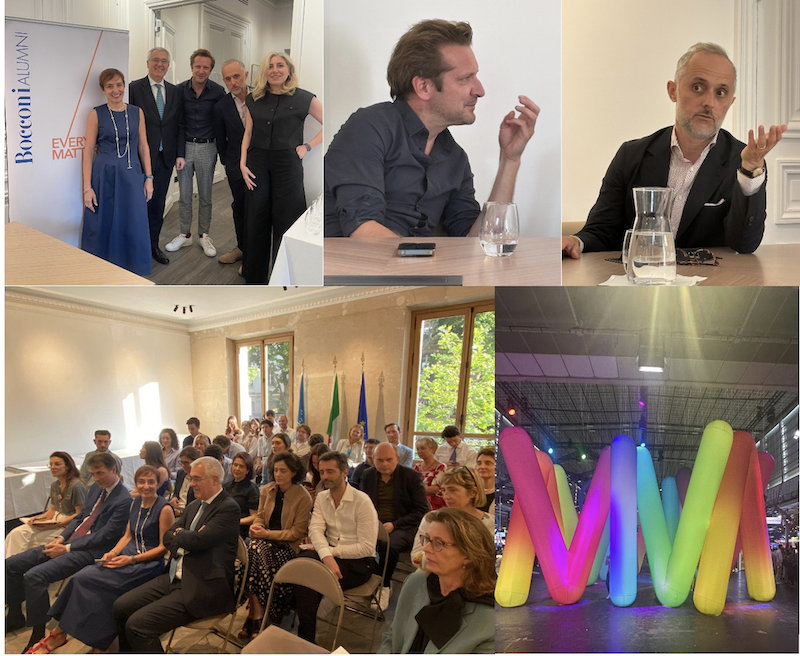Can AI Redefine Artistic Creativity?
AI and the Future of Work: Preserving the Human Touch in a Tech-Driven World
Sofia Balducci attended VivaTech in Paris, where she observed firsthand how AI is transforming industries from finance to healthcare. Drawing from these insights, she explores the critical questions surrounding AI’s role in creative work and human expression.
As seen at Vivatech in Paris, AI is now deeply embedded in daily life, transforming industries and the way we work. It powers real-time risk analysis in finance, sharpens diagnostics in healthcare, and optimises logistics. But beyond efficiency, AI prompts us to rethink the purpose of work, freeing us to focus on creativity, empathy, and strategic thinking, where human value is unmatched.

Yet with this transformation comes a cascade of urgent questions:
- Will AI displace jobs or simply redefine them?
- How can we prepare today’s workforce for a future where technological fluency is essential?
- And most critically, how do we ensure AI is a tool that serves humanity, not supplants it?
These were the central themes at the event “The Music of Intelligence: Humanism & AI in Creative Practice,” hosted by the Bocconi Alumni Paris chapter on June 11th at UNESCO headquarters in Paris.
The fireside chat featured Francesco Bottigliero – Chief of Humanistic Technology at Brunello Cucinelli, Foro delle Arti, and CEO of Solomei AI – and composer and conductor Laurent Couson. The evening delved into AI’s impact on music, a field long regarded as an intimate and emotional domain of human expression.
Rather than viewing AI as a threat to creativity, Bottigliero and Couson offered a more nuanced perspective: AI, when applied ethically and intentionally, can act as a powerful extension of human potential. This sparked a deeper question: Is AI truly creative, or merely imitative?
While many experts contend that AI cannot truly be creative, lacking intuition and emotional depth, others argue that, when directed by human input, AI can produce legitimate and meaningful artistic expressions. For instance, AI-based music tools like Suno AI can generate lifelike soundtracks by blending elements from various songs. However, this raises ethical and legal concerns around authorship and originality.
Couson highlighted the challenges in tracking the origins of such AI-generated pieces and called for practical solutions like watermarking, or clear distinctions such as labelling works as “AI-made” or “Human-made”, a practice already being discussed in the visual arts world.
One recurring theme throughout the discussion was the absence of comprehensive regulation. As generative AI continues to permeate creative fields, the risk of intellectual property violations grows. Both speakers emphasised the importance of enacting forward-thinking legislation, particularly in Europe, to safeguard cultural heritage and ensure that the creative professions, which are vital to our social fabric, are preserved and supported.
Creativity, Control, and the Artist’s Role
While fears around AI’s impact on creativity echo past reactions to technologies, history reminds us that new tools don’t eliminate art; they evolve it. AI should be seen as a new tool for artists, not a replacement. The real concern lies in who controls the tools. Many proprietary AI systems are developed by corporations that limit transparency and customisation. Although open-source alternatives offer more freedom, they are often too technical, creating new forms of gatekeeping.
Humans remain central in curating, designing, and refining AI-generated works. Thus, current generative art is more of a collaboration than a replacement. This makes education a vital frontier. Artists need both technical literacy and cultural depth to responsibly integrate AI into their practice. The danger isn’t AI replacing artists, it’s artists outsourcing too much of their vision to algorithms, losing their role as intentional co-creators.
What does the future hold?
As AI continues to evolve, so must our ethical, educational, and institutional frameworks. The conversation on June 11th demonstrated the importance of interdisciplinary dialogue in shaping the future of work and creativity. Investing in digital literacy, supporting the arts, and championing open, human-centred innovation are essential steps toward a future that is not just more efficient, but more meaningful.
In the age of data and automation, it is our collective responsibility to ensure that creativity, empathy, and purpose remain at the heart of progress. AI is here to stay. The challenge is not to resist it, but to wield it wisely.
0 comments